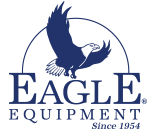We cannot stress enough how important it is to use the lift for the proper types of vehicles it is designed to handle. If you overload your lift, or do not do the proper maintenance to maintain your lift, you will encounter problems and your lift will not preform to the standards we recommend. If you want your Eagle lift to last you for many years to come, make sure you read the manual and do proper maintenance. Click here for daily, weekly and monthly maintenance recommendations.
1 – Maintain the proper hydraulic fluid and level needed or required to operate the lift. Eagle’s power units take AW-32 hydraulic fluid. DO NOT USE ATF (Automatic Transmission Fluid). Read this previous blog on selecting the correct oil for your Eagle Lift.
2- Adjust and maintain a proper adjustment on the lift cable at least every 3 months. Over time, the cables stretch and if not adjusted, a cable can jump a pulley or cause the lift to rise unevenly. Each cable should have about .5” of deflection (should not move more than .5”). This is true for a two-post or four-post lift. Adjustments are very simple to do and the steps are specific in the manual provided with your lift. Please look that over for instructions on how to adjust your cables.
3- Keep your chains and chain rollers lubricated to allow for less friction and proper movement. We recommend white lithium grease. You should do this weekly.

4- Apply a thin coat of lubricant on the carriage rub blocks (and part of the carriage that rub blocks touch) to allow less friction and wear as the lift moves up & down the lift with each use. We recommend white lithium grease spray for this as well.
5 – Repair all leaks or damages as soon as possible to prevent any further damage to existing parts and others it might affect being defective. If you need assistance on repairing, or replacing a part, please call our parts department at 800-535-0016.


My top rear lift blocks do not touch the post when a vehicle is on the lift. Is this normal?
Would be an indication that the arms/carriages are overloaded or the rub blocks are worn and need to be replaced and possibly shimmed.